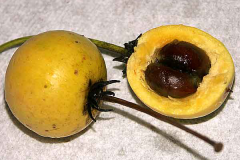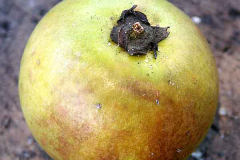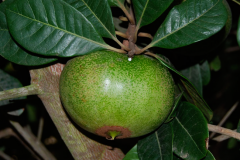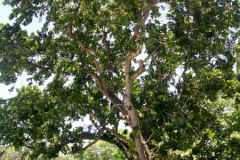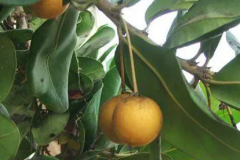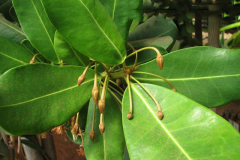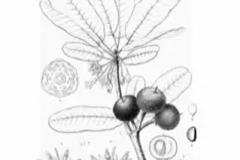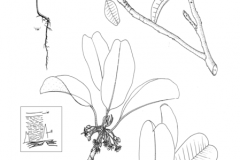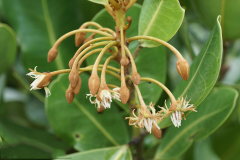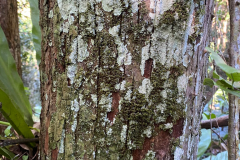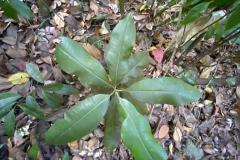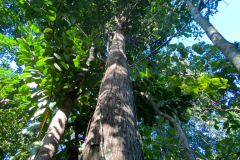| Balata Quick Facts | |
|---|---|
| Name: | Balata |
| Scientific Name: | Manilkara bidentata |
| Origin | Puerto Rico, widely distribute throughout the West Indies, and ranges from Mexico through Panama to northern South America, including the Guianas and Venezuela, to Peru, and to northern Brazil |
| Colors | Initially green turning to yellow as they mature |
| Shapes | Yellowish globose berry about 3–5 cm (1.2–2.0 in) in diameter |
| Flesh colors | White |
| Taste | Sweet and musky malty flavor |
| Health benefits | Good for diarrhea, dysentery, hemorrhage and paralysis of the limbs |
| Name | Balata |
|---|---|
| Scientific Name | Manilkara bidentata |
| Native | Puerto Rico, widely distribute throughout the West Indies, and ranges from Mexico through Panama to northern South America, including the Guianas and Venezuela, to Peru, and to northern Brazil |
| Common Names | Bulletwood, balatá, ausubo, massaranduba, quinilla, cow-tree, bully tree, common balata, Balata tree, bullet, bullet tree, cherry Mahogany |
| Name in Other Languages | Afrikaans: Balata Albanian: Balata Amharic: Balata (ባላታ) Arabic: Bilata (بلاطة), sbutat thunayiyat altasanun (سبوتة ثنائية التسنن) Armenian: Balat’a (բալաթա) Azerbaijani: Balata Basque: Balatondo Bengali: Balata (bəˈlätə) Brazil: Macaranduba, maparajuba Bulgarian: Balata (балата) Burmese: Balata (bəˈlätə) Chinese: Bā lā tǎ, Bā lā tǎ shù (巴拉塔樹) Croatian: Balata Czech: Balata Danish: Balata Dutch: Balata English: Balata, Bulletwood, Common balata, Balata tree, bullet, bullet tree, bully tree, cherry Mahogany Esperanto: Balata Estonian: Balata Filipino: Balata Finnish: Balata French: Balata, Bois de natte á feuilles de Poirier, bwa balata, bwa nwé, bwa négrès, sapotiy mawon, abeille, balata rouge, bois-noir Georgian: Balat’a (ბალატა) German: Balata , Balatabaum Greek: Baláta (Μπαλάτα) Guadeloupe: Balate, bois noir, sapotillier marron, sapotillier noir Gujarati: Bālatā (બાલતા) Hausa: Balata Hebrew: בלאטה Hindi: Balata (bəˈlätə) Hungarian: Balatára Icelandic: Balata Indonesian: Balata Irish: Balata Italian: Balata Japanese: Barata (バラタ), Makaranduba (マカランドゥバ), Masaranduba (マサランドゥバ) Javanese: Balata Kannada: Bālāṭā (ಬಾಲಾಟಾ) Kazakh: Balata (балата) Korean: Balla ta (발라 타) Kurdish: Balata Lao: Ba la ta (ບາລາຕາ) Latin: Balata Latvian: Balata Lithuanian: Balata Macedonian: Balata (балата) Malagasy: Balata Malay: Balata Malayalam: Bālata (ബാലത) Maltese: Balata Marathi: Bālāṭā (बालाटा) Martinique: Balate Mexico: Chicozapote Mongolian: Balata (балата) Nepali: Bālāṭā (बालाटा) Norwegian: Balata Oriya: ବାଲାଟା | Panama: Nispero Pashto: بالټا Persian: Balata (بالاتا), چوب گلوله Peru: Pamashto, quinilla Polish: Balata Portuguese: Balata, Balata-verdadeira, Maçaranduba, Macaranduba Punjabi: Bālatā (ਬਾਲਤਾ) Romanian: Balata Russian: Balata (балата), Massaranduba (Массарандуба) Serbian: Balata (балата) Sindhi: Balata (بالاتا) Sinhala: Bālaṭā (බාලටා) Slovenian: Balata Spanish: Balata, Acano, Ausubo, Balata, Balatá, Balata roja, Balato, Barbasco de monte, Caimitillo, Cohinillo, Cuberu, Leche de platano, Masaraduba, Mazaraduba, Nisperillo, Níspero, Níspero de montaña, Níspero montañero, Palo de chicle, Pamashto, Pendare, Pulvio, Purba, Purbio, Purgüey, Purguo, Purgillo, Purgo blanco, Purtgo morado, Purvio, Quinilla, Quinilla colorada, Trapichero, Yugo de charapa, zapote cimarrón, zapote mico Sundanese: Balata Suriname: Balata, bolletrie, parata Swedish: Balata Tajik: Balata (балата) Tamil: Pālāṭṭā (பாலாட்டா) Telugu: Balata-bəˈlädə Thai: Balata-bəˈlädə Trinidad and Tobago: Gooseberry Turkish: Balata Ukrainian: Balata (балата) Urdu: بالٹا Uzbek: Balata Venezuela: Acaná, pendare, purguo Vietnamese: Balata Welsh: Balata Zulu: Balata |
| Plant Growth Habit | Very large evergreen forest tree |
| Growing Climates | Moist coastal and limestone forests to lower mountain forests |
| Soil | Thrives on a variety of soils ranging from clays through sands, including rocky soils, and on several different geologic formations |
| Plant Size | 30-45 m (and exceptionally 50 m) tall and a diameter of 60-120 cm and branchless for up to 18 m |
| Bark | Bark is darkish, thick and evenly fissured; the under bark is pinkish and contains a milky latex – the balata gum of commerce |
| Leaf | Leaves are alternate, elliptical, entire, and 10–20 cm (3.9–7.9 in) long. |
| Flowering season | January to February |
| Flower | Flowers are white, and are produced at the beginning of the rainy season. |
| Fruit Shape & Size | Yellowish globose berry about 3–5 cm (1.2–2.0 in) in diameter, which is edible and usually consists of one or occasionally two seeds |
| Fruit Color | Initially green turning to yellow as they mature |
| Flesh | White, soft, and juicy |
| Seed | Single, shiny, black seed |
| Taste | Sweet and musky malty flavor and grainy texture |
| Propagation | By seeds |
| Season | April and May |
| Culinary Uses |
|
| Precautions |
|
Plant Description
Balata is a huge evergreen tree with a thick crown of horizontal branches and wide, round buttresses at the base. It can grow to be 30 to 45 meters tall, and sometimes even up to 50 meters tall, with a trunk that is 1.3 to 2 meters in diameter. In some cases, large boles can be up to 18 meters away from any branches. Most of the time, this plant grows in moist coastal, limestone, and lower mountain forests. It can grow well in different types of soil, like clay, sand, and even rocky soil, and it can also grow on different types of rock. Balata bark is thick, dark, and has even cracks. The under bark is pink and has balata gum, which is a milky latex. This plant makes wood that is twice as dense as oak or maple. It is very heavy and very hard.
Leaves, flowers, and fruits
The leaves of the balata tree are alternate, elliptical, and whole. They are grouped at the ends of the twigs. This leaf has a shiny green top and a light brown bottom. The tree has small, bright white or yellow flowers that grow in clusters along its branches at the start of the rainy season. After these flowers, a yellowish berry about 3–5 cm (1.2–2.0 in) in diameter, with one or sometimes two seeds grows. The seeds are shiny and black, and the pulp around them is sweet and sticky.
The leaves of the balata tree are used to treat paralysis in the limbs, and the latex from the stem is used to treat dysentery. This latex is called balata gum. The balata gum can be used for a lot of different things. For example, it can be used as a core for golf balls, as a filler in tooth fillings, and to make “mourning” jewelry.
Because it is so hard, heavy, tough, and strong, the wood from the balata tree is highly valued as a building material and for making furniture. It is very resilient to termites, fungi and dry borers. However, marine borers can damage it. The balata tree grows slowly and can handle strong winds very well.
Traditional uses and benefits of Balata
- People use the latex from the plant’s stems to treat dysentery.
- The bark has emetic properties.
- A decoction made from the bark of this plant, Humiria sp. and Hymenaea sp., is used to treat dysentery.
- Leaves are utilized for treating limb paralysis.
- Balata leaves are utilized by people to cure diarrhea, dysentery, and hemorrhages.
Other Facts
- The latex of this tree is used to make chicle, a product that is used a lot in industry.
- Balata was often used as the outer layer of high-quality golf balls to increase their spin rate, though they don’t travel as far as those with a Surlyn cover.
- In some areas, these trees have been known to produce sap for more than 25 years, which can be coagulated by fire or sun-drying and then used to make souvenirs or other items.
- Gutta-percha is a natural latex made from the sap of the tree.
- It can be molded into any shape and has been used to make ornate furniture, pistol grips, acid-resistant receptacles, “mourning” jewelry, and other things because of its dark color.
- Gutta-percha has also been used a lot to make golf balls and as a temporary filling material for teeth and fillings in modern dentistry.
- The wood of this tree is very hard, heavy, tough, strong, elastic, and durable, even when in contact with soil. This makes it resistant to fungi, dry wood borers, and termites, but not marine borers.
- This strong, attractive wood, which looks like mahogany, is commercially valuable and widely used in the tropics for railway sleepers, heavy construction, furniture, turnery, flooring, violin bows, billiard cues, and more.
- Due to its durability, strength and high wear resistance, timber is best for use in textile and pulp mill equipment.
- The wood’s outstanding steam-bending features make it ideal for boat frames and other curved work.
- Only 43% of the ausubo fruit is edible. The other 56.8% is made up of the skin (34.8% of the fruit) and the seed (22.2% of the fruit).
References:
https://www.itis.gov/servlet/SingleRpt/SingleRpt?search_topic=TSN&search_value=23825#null
https://pfaf.org/User/Plant.aspx?LatinName=Manilkara+bidentata
https://gd.eppo.int/taxon/MNKBI
https://en.wikipedia.org/wiki/Manilkara_bidentata
http://www.theplantlist.org/tpl1.1/record/kew-120114
https://www.cabidigitallibrary.org/doi/10.1079/cabicompendium.34536
https://www.srs.fs.usda.gov/pubs/misc/ag_654/volume_2/manikara/bidentata.htm
https://plants.usda.gov/home/plantProfile?symbol=MABI5



